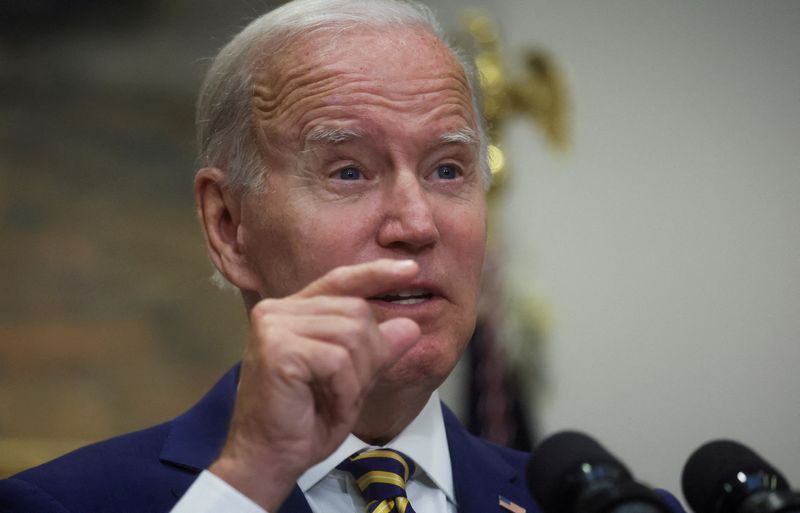By David Lawder
WASHINGTON (Reuters) - President Joe Biden's controversial plan to forgive up to $20,000 in student loans for tens of millions of Americans could erase the projected $300 billion deficit reduction that his hard-fought climate, drugs and tax legislation would generate over 10 years - by as much as two times.
The extent of the additional federal debt incurred by the one-time gift to college graduates and ex-students depends on which estimates are used, economists say.
Non-government budget analysts project the program's total 10-year cost at $500 billion to $600 billion, including extending a repayment pause on all federal student loans through Dec. 31 and reducing future payments based on income.
The White House initially dodged questions on costs, finally providing on Friday a "cash flow" estimate of foregone loan repayments of $24 billion a year, or about $240 billion over a decade - assuming that 75% of eligible borrowers apply.
Bharat Ramamurti, deputy director of the White House's National Economic Council, told reporters that the plan was fiscally justified because the federal deficit was on track for a $1.7 trillion reduction for fiscal 2022 compared to the prior year. The smaller deficit is largely due to the end of many COVID-19 aid programs and unexpectedly higher revenues.
"We're using a portion of that - a very small portion of it - to provide relief to middle-class families, consistent with the president's plan," Ramamurti said.
Some economists who track federal spending and workforce issues panned Biden's plan as offering unnecessary aid to many graduates who are financially well-off, potentially stoking inflation and running up deficits as borrowing costs rise.
They also said the move was puzzling just after the administration worked to bring down deficits in the newly signed "Inflation Reduction Act" with a 15% minimum corporate tax and new enforcement funding for the Internal Revenue Service.
The about-face just a week later "is bad economic policy," said Alan Auerbach, a public finance economist at the University of California, Berkeley. "To switch from saying 'we're doing this in a responsible manner' to turning around and blowing all the money they saved and more, from a policy perspective, it makes no sense."
Due to insufficient support in Congress, Biden is taking executive action to forgive $10,000 to $20,000 in student loan debt for individuals earning $125,000 and married couples up to $250,000. The plan could cost $440 billion to $600 billion over a decade, according to the Committee for a Responsible Federal Budget (CRFB) a non-partisan group advocating for deficit reduction, with a "central estimate".
The University of Pennsylvania's Penn Wharton Budget Model estimates the total cost at $605 billion, with debt forgiveness alone at $469 billion to $519 billion.
LOWER-INCOME DEBTORS BENEFIT MORE
But the Penn Wharton estimate shows that the bulk of the debt forgiveness - 74% - is likely to go to households earning less than $82,400 and under 5% would go to households earning more than $141,000. This may blunt some criticism of the program as aiding wealthy law and medical school graduates.
Some of those dollars "will end up in the pockets of people who don't need it, but proportionately, the bigger bang for the buck is at the low end," said Harry Holzer, a labor economist at Georgetown University.
Holzer, however, said he had concerns about "adding another half trillion dollars to the national debt, which is not trivial" after a $6 trillion COVID-19 debt run-up.
POPULAR MOVE
Biden has been under pressure to make good on his 2020 campaign pledge to forgive all undergraduate tuition-related federal student debt from two- and four-year public colleges and universities for debt-holders earning up to $125,000 a year. A new poll taken just before Biden's announcement last week indicated broad support for the general concept of student loan forgiveness.
Data for Progress, a left-leaning think tank, said its poll last week showed that 60% of American voters support eliminating some or all federal student debt, including 81% of Democrats, 52% of independents and 45% of Republicans.
Research indicates that an increasing share of U.S. undergraduate students come from poor and minority backgrounds and struggle after graduation with high debt payments and rising housing costs in urban areas.

A Pew Research study found that 20% of undergraduates were from families in poverty in 2016, up from 12% in 1996. The growth in the share of these students was most pronounced at private, for-profit institutions and less-selective colleges.
Deficits aside, economists said there are more effective ways to spend $500 billion to improve access to higher education and job skills, such as sharply increasing Pell Grants for low-income students, funding apprenticeship and training programs for in-demand fields, offering free community college and making further improvements to income-based repayments of loans. But these efforts would require stronger support in Congress.